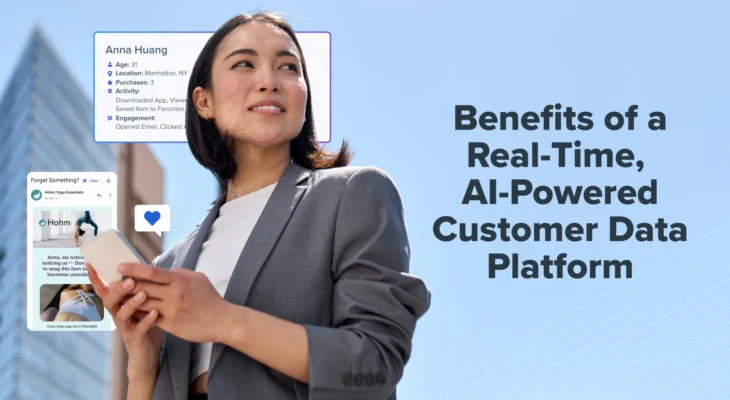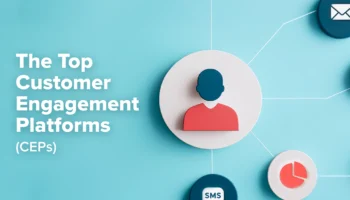Customer expectations have evolved. They no longer accept generic messaging; they expect contextually relevant, personalized experiences in real time. Yet many brands are stuck with fragmented data, siloed systems, and slow IT cycles. That is why more organizations are turning to Customer Data Platforms (CDPs).
A CDP unifies first-party data into a dynamic, real time profile, delivers faster insights, and enables activation across channels. The real impact comes when a CDP is both real time and AI powered, giving marketers the ability to move as fast as their customers.
According to Blueshift’s survey, 80% of marketing leaders say AI driven cross channel marketing has led to higher customer lifetime value, which shows why CDPs are at the center of modern strategies.
In this article, we answer “What are the benefits of a CDP?” and why it is becoming indispensable for modern marketing.
TL;DR: 9 Essential Benefits of a Customer Data Platform
A Customer Data Platform (CDP) unifies fragmented data into real-time, activation-ready profiles. The payoff: faster insights, personalized engagement across every channel, and measurable ROI. When powered by AI, a CDP not only centralizes data but also drives predictive, generative, and agentic use cases that increase customer lifetime value.
- Unified profiles: Stitch data from every source into a 360° real-time customer view.
- Eliminate silos: Give every team a single source of truth for consistent engagement.
- Agility for marketers: No-code tools remove IT bottlenecks and speed up campaign launches.
- Real-time personalization: Trigger contextual offers and messages in the moment.
- AI-driven insights: Predict churn, recommend products, and optimize timing with predictive, generative, and agentic AI.
- Retention and CLV: Use churn scores and recommendations to drive loyalty and repeat purchases.
- Compliance built-in: Centralized consent management ensures regulatory adherence.
- Operational efficiency: Consolidate tools, cut costs, and accelerate time-to-value.
- B2C + B2B unification: Support both individual and business profiles in one strategy.
What Are the Benefits of a CDP?
Let’s dive deeper into the 9 essential benefits of a Customer Data Platform and why a real-time approach gives marketers a distinct edge.
1. How does a CDP create unified customer profiles (360° view)?
Most brands have customer data scattered across CRMs, analytics tools, ecommerce platforms, and loyalty systems. A CDP stitches these disparate touchpoints together into single, dynamic profiles. Every purchase, click, and offline transaction is reflected in one place. These profiles update in real time, not overnight with slow batch jobs. Marketers can see not just who the customer is, but how they behave.
Most brands struggle with fragmented data across CRMs, analytics tools, e commerce platforms, and offline systems. A CDP consolidates all of these into a single, constantly updated profile. Because it updates in real time (not via overnight batch jobs), marketers see not just who the customer is, but how they behave in the moment.
Case in point: Leading financial services company, LendingTree, unifies user behavior across email, SMS, and web to deliver highly relevant offers—increasing conversion rates on financial products. This level of insight is impossible when data lives in separate silos.
2. How does a CDP eliminate data silos across teams?
Without a CDP, different departments use disconnected datasets: marketing sees one version, product another, and IT yet another. This creates inconsistent messaging and missed opportunities.
A CDP provides a single source of truth that powers every team. Everyone speaks the same language when it comes to customer data, ensuring a cohesive and seamless experience for the customer, no matter which team they interact with.
3. How does a CDP democratize data and reduce IT dependence?
Traditional segmentation and campaign activation often require complex SQL queries, ETL pipelines, and data engineering support. This creates a bottleneck that slows down innovation.
A CDP gives marketers direct access to the data they need through an intuitive UI and drag-and-drop segmentation tools. This means no more waiting on engineering queues, faster testing and iteration, and greater marketing agility.
Example: Ent Credit Union reduced the time it takes to build a new audience from 25 hours over two weeks to just minutes.
This freed marketers to launch campaigns when they matter most, like during a timely financial event, rather than after the moment has passed.
4. What does real time personalization enable?
Customer intent can change in seconds. A standalone, batch-based system simply can’t keep up. Without real-time personalization, you risk losing engagement and revenue.
- A shopper abandons a cart on your website → an email is triggered instantly.
- A traveler checks their flight status → a push notification with a gate change is sent within seconds.
- A finance customer crosses a credit utilization threshold → a personalized offer for a balance transfer is delivered right away.
5. What AI capabilities does an integrated CDP and CEP provide (predictive, generative, agentic)?
Many vendors stop at “AI personalization.” An integrated CDP and CEP stack delivers much more because it not only unifies data but also activates it instantly across channels:
- Predictive AI: Provides scores for the likelihood of a customer to churn, purchase, or engage with a campaign. This allows you to proactively target at-risk or high-value customers.
- Agentic AI: Drives next-best-action recommendations and autonomously optimizes campaigns based on real-time customer behavior, ensuring you are always sending the right message at the right time.
- Generative AI: Auto-creates high-performing content like subject lines, product descriptions, and dynamic email blocks, significantly reducing manual work and creative bottlenecks.
This layered AI approach helps brands anticipate intent, adapt campaigns in real time, and reduce the manual effort required to deliver personalized experiences.
6. How does a CDP maximize retention and customer lifetime value (CLV)?
Acquiring new customers is expensive. A CDP helps maximize the value of existing ones by:
- Identifying at-risk customers with churn models.
- Serving personalized retention offers to save valuable relationships.
- Driving repeat purchases through intelligent recommendation engines.
Example: Slickdeals used Blueshift’s predictive churn scores to re-engage high-value users, resulting in increased loyalty and revenue.
7. How does a CDP ensure regulatory compliance?
Customer trust is paramount and depends on robust data privacy practices. A CDP centralizes consent management and ensures compliance with global regulations like GDPR (Europe), CCPA (California), HIPAA (Healthcare), and SOC2 Type II.
Blueshift also provides audit logs, encryption, and SSO, giving enterprises the peace of mind that their customer data is secure and compliant.
8. How Does a CDP Boost Operational Efficiency
Every new point solution in your martech stack adds complexity, cost, and a new layer of manual work. By combining data, AI, and orchestration into one system, Blueshift helps companies:
- Reduce licensing costs from multiple vendors.
- Cut down on manual integrations and maintenance.
- Deliver faster time-to-value by enabling marketers to move independently.
According to a recent Blueshift survey, 78% of marketers say that CDPs helped them launch campaigns faster and operate with greater efficiency.
9. How Does a CDP Unify B2B and B2C Strategies?
Many organizations sell to both individuals and businesses (think SaaS, finance, and healthcare). This often leads to a split tech stack and disconnected strategies.
A CDP unifies both profile types into a single engagement strategy, supporting upsell and cross-sell opportunities with a holistic view of the customer relationship.
What are the benefits of a real-time CDP?
A real-time CDP goes beyond simple data unification. It’s a foundational technology that allows for true customer-centric engagement. Its key advantages include:
- Capturing signals as they happen, not waiting for a daily data dump.
- Enabling instant triggers for time-sensitive marketing campaigns.
- Powering truly contextual marketing based on a customer’s current state and recent actions.
For industries like ecommerce, travel, and finance, this speed translates directly to increased revenue and improved customer satisfaction.
How Does a CDP Improve Marketing?
By improving both efficiency and effectiveness. With a CDP, marketing becomes more data-driven and agile, leading to:
- Campaign setup in minutes, not weeks.
- Hyper-relevant segmentation with AI.
- Seamless cross-channel personalization.
- Clear measurement of CLV, retention, and ROI.
The result: marketing that feels more human, helpful, and timely, leading to a better customer experience and stronger brand loyalty.
Who Needs a CDP and Why?
A CDP is not just for tech giants. It is a critical tool for any business that has fragmented customer data and operates across multiple channels.
| Industry | Key Use Case |
| Retail and E-Commerce | Trigger price drop alerts, personalized promos, back-in-stock nudges |
| Finance and Credit Unions | Build trust and engagement while staying compliant |
| Media and Streaming | Deliver content and subscription offers based on real-time behavior |
| Healthcare and EdTech | Enable secure, tailored communication for patients or students |
How Is a CDP Different From a CRM?
While a CRM and a CDP both work with customer data, they serve fundamentally different purposes.
| Platform | Purpose | Limitation | CDP Advantage |
| CRM | Tracks sales and service interactions. | Not built for marketing personalization or unifying data from all sources (e.g., website clicks, app behavior). | CDPs unify all first-party data, not just sales and service records. |
| CDP | Unifies customer data across all sources for marketing activation. | N/A | Powers AI-driven, real-time, omnichannel journeys based on a complete customer profile. |
For a closer look at how CDPs differ from CRMs and Data Warehouses, see our blogs on CDP vs Data Warehouse and CDP vs CRM.
Is a CDP Worth the Investment?
Yes, absolutely—and the ROI is measurable. A CDP pays for itself through:
- Revenue lift (higher CLV and repeat purchases).
- Churn reduction (predictive targeting).
- Cost savings (simplified tech stack and reduced IT reliance).
Unlock the Full Benefits of a CDP
The benefits of a Customer Data Platform extend far beyond simply unifying data. With real-time capabilities, AI-powered insights, and cross-channel activation, a CDP helps brands deliver experiences that customers actually value.
Many teams stitch together a CDP plus a separate engagement platform (CEP). The result is an expensive, complex stack with integration overhead.
Blueshift combines CDP and CEP in one platform. That means you unify profiles, apply AI, and orchestrate journeys across email, SMS, push, web, in app, and ads, all from a central hub. This reduces integrations, speeds execution, and lowers costs.
Ready to unlock the benefits of a CDP and transform your customer engagement? Request a demo of Blueshift to see it in action.




